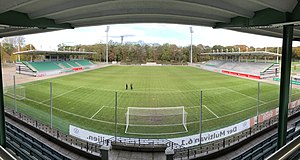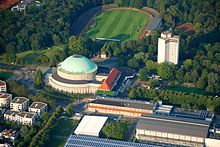Eilenriedestadion
| Eilenriedestadion | |
|---|---|

|
|
| Panoramic view from the old grandstand | |
| Earlier names | |
|
96 - THE STADIUM (2016–2017) |
|
| Data | |
| place | Clausewitzstrasse 4 30175 Hannover , Germany |
| Coordinates | 52 ° 22 '35.7 " N , 9 ° 46' 22.4" E |
| owner | Hannover 96 GmbH & Co. KGaA |
| opening | 1922 |
| Renovations | 2005, 2016 |
| surface | Natural grass |
| capacity | 2500 seats (expandable to 5000) |
| Societies) | |

The Eilenriedestadion (sometimes also called 96 - DAS STADION ) is a football stadium in the Lower Saxony state capital Hanover . It is the venue for the youth teams and the second men's team of the Hannover 96 football club , located on the edge of the Eilenriede forest . In October 2016, the club initially renamed the renovated Eilenriedestadion “96 - THE STADIUM”. As a result, after the renaming, the stadium was mostly called "96-Stadion in der Eilenriede", and the media and club have been using the name Eilenriedestadion again since the end of 2017. The name "96 - the stadium" is still present on some signs on site.
description
Stadium building
The stadium traditionally consists of a roofed grandstand that can seat around 500 spectators. The changing rooms and sanitary rooms are also located in this grandstand. Until 2016, this stood on one side of the pitch, after the renovation in 2016 it was now behind the goal of the newly created pitch. In the previous opposite stand there were around 500 seats in the form of benches. Otherwise, the stadium consisted of flat stands, on which there was only standing room. The capacity of 18,000 spectators was a theoretical figure in the last few years up to 2016, as the standing bars would by far not meet today's safety requirements. Most of the time, only the seats on the main stand and the bench opposite were in use.
During the renovation in 2016, the pitch was rotated 90 degrees so that the old covered grandstand is now the back gate. Most of the other grandstands were demolished, only the standing grandstands of the west curve, now far outside the interior, remained standing and were planted with a small wall. On both long sides of the new playing field, small covered grandstands with around 1000 seats each were built. The athletics facility has been removed. The system now has a capacity of 2,500 places, which can be expanded to 5,000 places. The converted venue was inaugurated at the end of October 2016.
Young talent center of Hannover 96
The stadium building is part of the youth performance center of Hannover 96. The current training area comprises three grass pitches and four artificial turf pitches, which are used by all youth teams.
Forest school
The so-called forest school , which belongs to the Kestnerstraße elementary school, is located on the grounds of the Eilenriedestadion . It consists of a small building that houses a classroom. This gives the students of the Kestnerschule the opportunity to take part in clear and practical lessons in nature in the summer.
Hockey Club Hannover
Since 1924 the area of the Eilenriedestadion is also the location of the hockey club Hannover . With its hockey, tennis, cricket and beach volleyball divisions, the club currently maintains an artificial turf field, two additional training fields for hockey and cricket, a beach volleyball court and four tennis courts.
history
The Hanover city director Heinrich Tramm was able to win over the patron Gustav Brandt to provide 300,000 gold marks for the construction of a stadium in Hanover. Brandt set the condition that there should be a reference to this donation in the stadium on the occasion of Paul von Hindenburg's "40th" military anniversary on April 7, 1916. He also limited the construction time to five years, otherwise he would withdraw from the donation. However, his foundation allowed an extension of the deadline after Brandt died in 1918 and the construction period dragged on.
The stadium was opened in 1921 under the name “Stadium of the City of Hanover”, because the name “Hindenburg Stadium”, requested by Brandt, could not be implemented in the city council at that time. Therefore, many celebrities stayed away from the official opening. Regardless of the official name, the Hannoversche Kurier used the name "Hindenburg Stadium" in its articles. One of the pillars at the entrance was labeled “Hindenburg Kampfbahn der Stadt Hannover, built 1921” . The stadium held 25,000 spectators at that time.
The court clockmaker M. Stellmann donated the stadium clock with the inscription of his business address "Königstrasse" and which has been preserved to this day.
Shortly after the start of the Nazi era , the stadium was officially renamed the "Hindenburg-Kampfbahn" in 1934. 1931 and 1937 were in this stadium football - internationals against Denmark (4: 2) and Belgium (1: 0) held. In addition, it was an alternative stadium for Hannover 96 for the nearby (old) cycling track, which was demolished in 1958. The attendance record for an international match against Belgium on April 25, 1937 was 54,800. After the Second World War it was officially called the “Stadium of the City of Hanover” again, but was used from 1945 to 1951 by the British Army of the Rhine , which continued to use the name “Hindenburg Stadium”. On December 1, 1951, the stadium was returned to the city of Hanover as the "Eilenriedestadion".
Hannover 96 did not play regularly in the Eilenriedestadion. The Eilenriedestadion was also used as an alternative venue for the professionals, e.g. B. 1974 against Kaiserslautern, when the Lower Saxony Stadium was rebuilt for the 1974 World Cup .
After the Eilenriedestadion was the club's official domicile from 1956, Hannover 96 moved to the Niedersachsenstadion in 1959 . The youth teams continued to play in the Eilenriedestadion, but the second team from Hannover 96 had to leave the Eilenriedestadion in 2008 because it was no longer approved by the DFB for the regional league. She played temporarily in the Lower Saxony Stadium, which was then known as the “AWD Arena” for a limited period of time, and a little later in the very small Beekestadion , which was approved for the regional league and is the home of the district club Sportfreunde Ricklingen . Since the renovation in 2016, the 2nd team has been playing in the Eilenriedestadion again.
In 2005 the stadium was partially refurbished and served as a training facility during the Confederations Cup 2005 . Behind one of the gates was a small football pitch made of artificial turf .
In May 2014 Hannover 96 decided to set up a youth performance center on the grounds of the Eilenriedestadion. The monument protection was taken into account in the redesign. The stadium building itself was only allowed to be changed in the area of the cinder track, the standing grandstands and in the area of the uncovered seating grandstand. The gatehouses, the clock in the entrance area, the western semicircle of the ramparts and the grandstand building from 1928 to the south have been preserved. The forest school of the Kestnerstraße elementary school remains accessible to the same extent as it was before. The measure was made possible by the Hannover Hockey Club by agreeing to move within the Eilenriedestadion. To this end, he was given an area of around 21,000 square meters in the south of the site. He took over the five tennis courts from Hannover 96 and built an artificial turf field for hockey and a beach volleyball field there . The existing club building at Hannover 96 was partially converted and continued to be used by the Hannover Hockey Club.
During the renovation of the Eilenriedestadion in 2015/16 as part of the construction work in the youth performance center, only the covered main grandstand remained, all other grandstands and the running track were removed, the playing field turned 90 degrees and small covered grandstands were built on the new long sides. The capacity is now only 2500 spectators, it can be expanded to up to 5000 spectators. The new Eilenriedestadion, which opened in October 2016, was given the name "96 - THE STADION" by the association. Because the new name was rejected by the public, notices from Hannover 96 also included formulations such as B. "96-Stadion an der Eilenriede" is used. The original name Eilenriedestadion has been used again since the end of 2017.
literature
-
Adelheid von Saldern : Sport and Public Culture. The inauguration of the Hanover stadium in 1922 ,
- in Hans-Dieter Schmid (Ed.): Festivals and celebrations in Hanover (= Hannoversche Schriften zur Regional- und Lokalgeschichte ; Vol. 10), Bielefeld: Verlag für Regionalgeschichte, 1995, ISBN 978-3-89534-143-4 and ISBN 3-89534-143-6 , pp. 169-211
- in this: politics - city - culture. Essays on the history of society in the 20th century , published by Inge Marßolek and Michael Wildt on his 60th birthday, 1st edition, Hamburg: Results-Verlag, 1999, ISBN 978-3-87916-051-8 and ISBN 3-87916-051- 1 , pp. 121-143
- Christian Wolter: The Eilenriede Stadium - Germany's first urban stadium , in which: On the history of the football stadiums in Hanover. In: Hannoversche Geschichtsblätter , New Series 60 (2006), pp. 5f., 25-30
- Karl-Heinz Grotjahn MA: Eilenriedestadion. In: Klaus Mlynek, Waldemar R. Röhrbein (eds.) U. a .: City Lexicon Hanover . From the beginning to the present. Schlütersche, Hannover 2009, ISBN 978-3-89993-662-9 , p. 152.
- Edzard Schönrock: Eilenriedestadion: conversion taking into account the preservation of monuments / conversation with 96-President Martin Kind. In: home country . Journal of the Heimatbund Lower Saxony , issue 3 / September 2014, p. 101f.
Web links
- Short version of the story and black and white photo ( Memento from September 28, 2007 in the Internet Archive )
- europlan-online.de: Eilenriedestadion (old) - Hanover
- europlan-online.de: 96 - THE STADIUM - Hanover
References and comments
- ↑ hannover96.de: U21: 96 - DAS STADION is inaugurated Article from October 28, 2016
- ↑ Section stadium and training grounds on the Hannover 96 website , accessed on November 2, 2014
- ↑ Description of the forest school on the website of the Kestnerstraße elementary school , accessed on November 2, 2014
- ^ Description on the website of the Hockey Club Hannover , accessed on November 2, 2014
- ↑ In 1876, Hindenburg graduated from the War Academy in Berlin with the qualification for the general staff
- ↑ a b c d Barbara Schmidt-Vogt: The zoo district in Hanover - history of a district , Hanover 2012
- ↑ n.v . : From the beginning: The Eilenriedestadion in Hanover , illustrated description of the stadium with a picture of Stellmann's grandfather clock on the website of the architects Schulze & Partner [undated], last accessed on July 31, 2019
- ↑ a b Hannover 96 - Young Talent Center: Concept is in place ( Memento of the original from December 22nd, 2015 in the Internet Archive ) Info: The archive link was automatically inserted and not yet checked. Please check the original and archive link according to the instructions and then remove this notice. Notification on the website of the City of Hanover, accessed on May 14, 2014
- ↑ Here wants to promote 96 talents - New Young Talent Center , Hannoversche Allgemeine Zeitung from May 14, 2014
- ↑ Hannover 96: Die U23 , accessed on July 28, 2018




